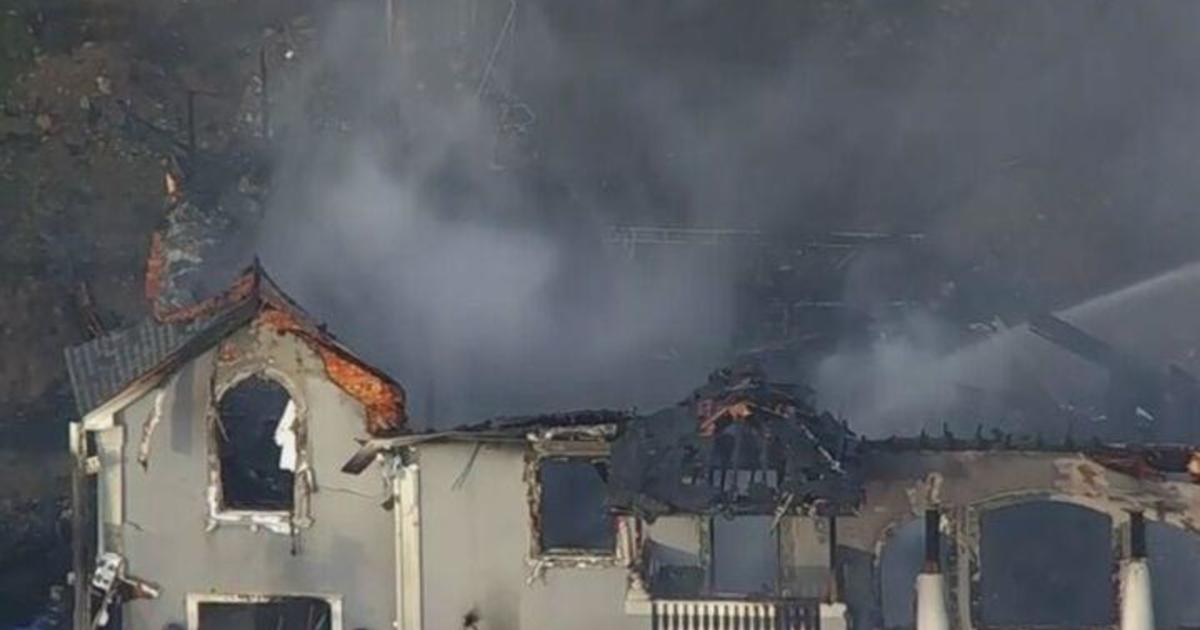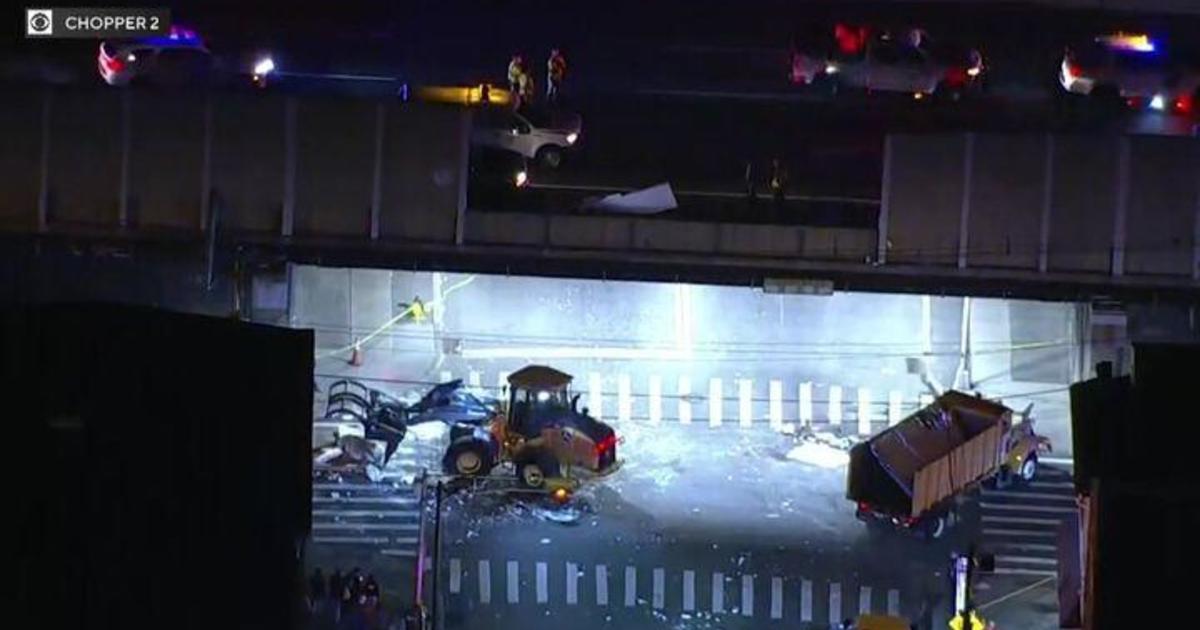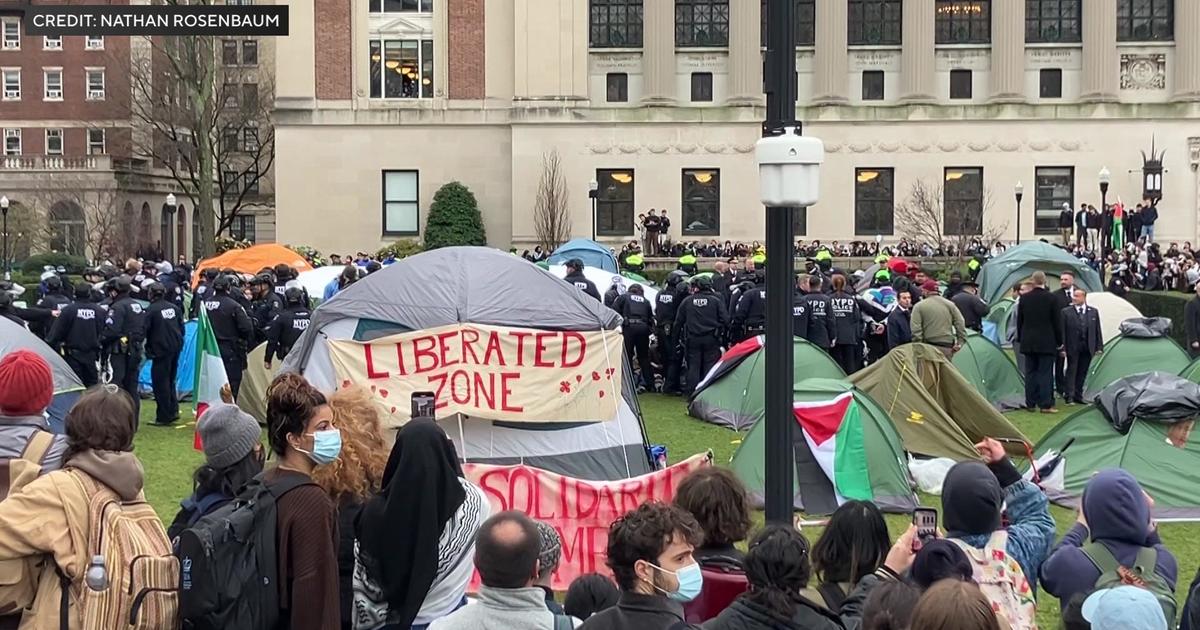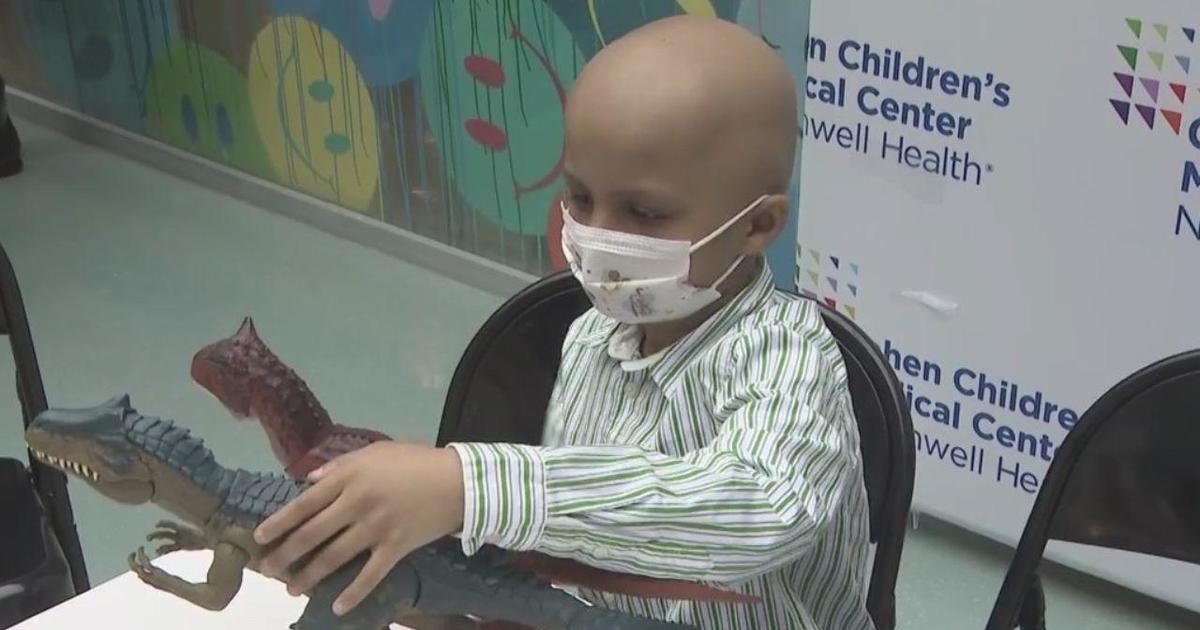Thousands Rescued From Flooding As Harvey Batters Houston
HOUSTON (CBSNewYork/AP) — Tropical Storm Harvey was far from finished with Texas late Monday, as forecasters said it continued to batter parts of the state with relentless rain.
As James Allen of CBS DFW reported, heavy rain started falling early Monday morning and didn't stop all day. The water had started to go down in some neighborhoods, but hour by hour Monday, it started to rise again.
CBS2's Lonnie Quinn reported as of 11 p.m. Monday, the wind was spinning at 45 mph, but tracking at only 3 mph. The latest track shows the storm making a U-turn later in the week and making a second landfall and targeting northwestern Louisiana.
Photos: Southeast Texas Devastated By Harvey | Harvey Flooding: How You Can Help
The storm likely will not leave Texas altogether until late Wednesday.
As to rain totals, Harvey has already topped out at 42.86 inches – more than the combined total for Katrina at 16.33 inches, Andrew at 13.96 inches, and Sandy at 12.55 inches. The estimated final total is expected to hit 45 to 55 inches.
The National Weather Service even added two new colors to deal with record rainfall levels on weather maps.
As CBS News' Kenneth Craig reported, federal officials in Houston were asking for the public's help to rescue thousands late Monday.
Meanwhile, neighbors were saving neighbors.
"I just tried to save people that are stuck in their homes," said volunteer Clint Wingar. "It's too much for the first responders. They need help."
Emergency crews have been left overwhelmed.
Houston Mayor Sylvester Turner Monday night that authorities have rescued 3,000 people from flooding in the city since Friday evening, and more than 1,000 in the afternoon and evening hours Monday alone. But thousands more were still waiting for help to arrive.
"Our goal is to try to get everyone out today and relieve them of their stressful situation," Turner said.
The Federal Emergency Management Agency was urging boat owners to join the rescue effort.
"We need citizens to be involved," said FEMA Administrator William "Brock" Long. "This is a landmark event."
Many strangers have been stepping in to answer the call. As J.D. Miles of CBS DFW reported, one Houston area mother could not contain her emotions as she hopped onto a boat with her children.
"Y'all don't know how scared I was," she said.
The reactions of those relieved to be rescued made the risk volunteers are taking worth the reward.
"Thank God we had the opportunity to come help them," said Eric Strakos.
Strakos and Joe Willesden left their jobs to canvass neighborhoods, where stranded homeowners like the Lopez family have been pleading for someone to save them.
"We were ready to go," said Sergio Lopez. "You were just waiting on help, we got a busy signal all night yesterday to Coast Guard nobody answered the phone."
By 8 a.m. Monday, Strakos and Willesden had rescued 60 people, some who had been waiting more than 24 hours.
Rising water also chased Fabian Perez and his young children out of their home overnight.
"Nobody has shoes. We just took whatever we could," he said. "The water was waist deep all the way along."
Some people used inflatable beach toys, rubber rafts and even air mattresses to get through the water to safety. Others waded while carrying trash bags stuffed with their belongings and small animals in picnic coolers.
And it's not just people who have needed saving.
Storm chaser Aaron Jay Jack said a dog jumped into his sport utility vehicle at a gas station in Runge, Texas on Saturday. He nicknamed the pup "Harvey" and posted a video on Twitter.
The post soon went viral and the dog's owners were tracked down. Jay Jack later dropped off the dog at its home.
But as CBS2's Hazel Sanchez reported, rescue crews with boats were forced to bypass scores of flood victims because they have been directed to help others.
In many cases, people have been plucked by helicopter crews.
Some of the stranded made the mistake of not leaving home when they could.
"I didn't want to drive out to our family that's four hours away in central Texas. I didn't feel that was safe either. I didn't want to be on the road," one woman said as she held a little girl in her arms. "And now look at me. We're in the middle of I-45."
Some could not leave – like residents of a nursing home that flooded. The owner of the Dickinson Facility lives in Florida, but spoke Monday by phone.
"These people could easily have died. They're on oxygen," she said.
Several reporters covering the story also became rescuers. Brandi Smith of Houston CBS affiliate KHOU 11 got help for a stranded trucker.
KHOU's building ended up flooding, so Smith was the only person on air Sunday. But she still got help for the man.
"I just thank God that you guys were right here to get me, put me back on land, safe," Smith said. "I appreciate you."
A deputy told Smith that the spot where she rescued the truck driver was the same site where a truck driver died during the Tax Day flood last year.
Hurricane rescue crews in some Houston neighborhoods Monday were made up of men and boys in canoes. Police did not have boats and could only wade in so far.
Constables answering calls for help turned to volunteers to paddle people out.
"The bayou ravine is right behind our house," said Suzi Russell, "and we've had terrible floods before, and it never came up, so we really thought we were bulletproof."
In a disaster where people have had to rely on themselves and their neighbors, the Russells found friends on higher ground who gave them a place to stay. But other evacuees were not sure where to go next.'
"Now it's flooded, so I'm trying to get out of here before I get flooded in here," said Tina Butler.
Butler was packing Monday night for her second evacuation. She and her daughter and son-in-law left Corpus Christi when the storm was headed there.
They thought Houston would be safe, but have now decided it would be better to go back to the damage on the coast.
"No electricity, water boil and scarcity of gas at home. But that's OK," Butler said. "I can deal with that. I don't want to be in this flood water."
People have been paddling through the streets, shouting their phone numbers to people who were still on the second stories of homes late Monday, just in case the water keeps going up and they decide they too want to get out.
As the water rises, Texas Gov. Greg Abbott has deployed the entire Texas National Guard to help with search and rescue.
Late Monday, the governor added four East Texas counties to the 54 Southeast Texas counties already covered by his Hurricane Harvey disaster declaration. He added Angelina, Trinity, Sabine and Orange counties to the counties already declared disaster areas.
Thirty thousand people are expected to crowd into dozens of shelters. Mayor Turner said late Monday afternoon that the city was working on opening another "major" shelter for people fleeing flooding as the George S. Brown Convention Center reaches capacity.
Turner toured the convention center Monday, hugging evacuees and asking how they were doing. The convention center was already more than halfway to its 5,000-person capacity. He said the city was considering its options for another major shelter, but did not say which buildings could be used.
The convention center was also used as a shelter for Katrina refugees in 2005.
Meanwhile, hundreds more hunkered at a local church.
"We all lost everything," said Wanda Wilson. "We don't know where we're going. We don't know nothing. We just thank God we got life."
Nerves are frayed at many of the shelters, where neighbors have little else but each other.
"They're completely soaked," one woman said. "I don't even know what to say, they're not even my kids but I tell you what I love them like they're my own. And I don't know them from Adam."
Meantime late Monday, the first group of evacuees were airlifted to Dallas.
A steady rain met a U.S. Air Force C-130 transport plane as it landed at Dallas Love Field about 6:30 p.m. Monday with about 70 evacuees. Pet dogs barked as evacuees carrying trash bags and backpacks were loaded onto a bus shortly after landing.
Dallas County Judge Clay Jenkins says the plane was the first of a possible eight planeloads of evacuees expected to be flown into Dallas.
The evacuees will be housed at smaller emergency shelters around the Dallas-Fort Worth area while city workers, partner organizations and volunteers finish preparing the Kay Bailey Hutchison Convention Center in downtown Dallas. Jason Carriere is the police department emergency management coordinator in the Dallas suburb of Irving. He said in a Monday email that Irving's makeshift emergency shelter was prepared to take in about 200 people.
As many as 5,000 evacuees may begin arriving some time Tuesday.
Harvey, which made landfall late Friday as a Category 4 hurricane and has lingered just off the coast dropping heavy rain as a tropical storm, sent devastating floods pouring into Houston on Sunday.
The rising water chased thousands of people to rooftops or higher ground and overwhelmed rescuers who could not keep up with the constant calls for help.
"We realize there are people out there and we will get them," said Mayor Turner.
Long said during a news conference Monday that as many as 50 counties in Texas are affected by the flooding and that a tremendous amount of rainfall is in the cards for southwest Louisiana too.
"This is still an ongoing situation," he said. "It's very important -- this is a life safety, life-sustaining mission."
The National Weather Service meanwhile warned that the catastrophic flooding would worsen due to heavy rainfall in the coming days and that it would be slow to recede once Harvey finally moves on.
Director Louis Uccellini said during a news conference Monday that up to 20 inches of rain could fall in the coming days, on top of the more than 30 inches some places have already seen.
On Monday morning, emergency vehicles made up most of the traffic in an otherwise deserted downtown Houston — normally a bustling business area. Many traffic signals did not work and most businesses were closed.
Residents living near the Addicks and Barker reservoirs — that were designed to prevent flooding in downtown Houston — were warned Sunday that a controlled release from both reservoirs would cause additional street flooding that could spill into homes.
Rising water levels and continuing rain was putting pressure on the dams that could fail without the release. Harris and Fort Bend county officials advised residents to pack their cars Sunday night and leave in the morning.
The Army Corps of Engineers started the reservoir releases before 2 a.m. Monday — ahead of schedule — because water levels were increasing dramatically at a rate of more than six inches per hour, a Corps spokesman Jay Townsend said.
The timetable was moved up to prevent more homes from being flooded, Townsend said.
"We are releasing smaller amounts of water now to prevent larger uncontrolled releases when the water starts going around the dam," said Deputy District Engineer for the U.S. Army Corps of Engineers Galveston District Dr. Edmond J. Russo.
Meanwhile, officials in Fort Bend County, Houston's southwestern suburbs, late Sunday issued widespread mandatory evacuation orders along the Brazos River levee districts. County officials were preparing for the river to reach major flood stages late Sunday.
County Judge Robert Herbert said at a news conference that National Weather Service officials were predicting that the water could rise to 59 feet, three feet above 2016 records and what Herbert called an "800-year flood level."
Herbert said that amount of water would top the levees and carries a threat of levee failure.
The flooding was so widespread that authorities had trouble pinpointing the worst areas. They urged people to get on top of their houses to avoid becoming trapped in attics and to wave sheets or towels to draw attention to their location.
Judging from federal disaster declarations, the storm has so far affected about a quarter of the Texas population, or 6.8 million people in 18 counties. It was blamed in at least two deaths -- and that number is expected to rise.
"The breadth and intensity of this rainfall is beyond anything experienced before," the National Weather Service said in a statement.
Rescuers had to give top priority to life-and-death situations, leaving many affected families to fend for themselves. And several hospitals in the Houston area were evacuated due to the rising waters.
Meanwhile, the deteriorating situation was bound to provoke questions about the conflicting advice given by the governor and Houston leaders before the hurricane. Gov. Greg Abbott urged people to flee from Harvey's path, but the Houston mayor issued no evacuation orders and told everyone to stay home.
The governor refused to point fingers on Sunday.
"Now is not the time to second-guess the decisions that were made," Abbott, a Republican, said at a news conference in Austin. "What's important is that everybody work together to ensure that we are going to, first, save lives and, second, help people across the state rebuild."
The mayor, a Democrat, defended his decision, saying there was no way to know which parts of the city were most vulnerable.
"If you think the situation right now is bad, and you give an order to evacuate, you are creating a nightmare," Turner said, citing the risks of sending the city's 2.3 million inhabitants onto the highways at the same time.
The Coast Guard deployed five helicopters and asked for additional aircraft from New Orleans.
Volunteers from the New York and New Jersey Red Cross are joining 120 emergency personnel from New York City who are heading to Texas to help with rescue and recovery efforts.
A team of 19 New Jersey Red Cross volunteers headed to Texas late Monday to help those affected by Hurricane Harvey.
The team from the urban search and rescue New York Task Force is made up of FDNY and NYPD members who have been specially trained to deal with major disasters.
"Deploy up to 14 days, can do structural searches, wide-area searches and also swift water rescue," said John Grimm with New York Task Force 1.
As WCBS 880's Peter Haskell reported, 1,000 FEMA staffers have also been sent to Texas – more than 75 of them from the Tri-State Area. Andrew Martin of FEMA Region 2 expects the agency will do whatever it takes.
"Our number one customer is the taxpayer and we don't see politics," Martin said.
A group of rescuers who learned their lessons in the crucible of the World Trade Center rescue and recovery after the Sept. 11, 2001 attacks was also headed out Monday.
"We will be heading down to assist in the high water rescue," said Bill Keegan, the founder of Hard 9/11. "This is one of the ways that we heal is by helping others."
Hard 9/11 has answered the call for help more than 60 times.
In New York, the lights on the Empire State Building were turned off in sympathy with those affected by Harvey.
Back in Texas, the Houston Astros donated $4 million for Harvey relief, the Houston Rockets also donated $4 million, and the Houston Texans donated $1 million.
The White House announced that President Donald Trump would visit Texas on Tuesday. He met Sunday by teleconference with top administration officials to discuss federal support for response and recovery efforts.
On Monday, Trump issued a federal emergency disaster declaration for Louisiana, covering Beauregard, Calcasieu, Cameron, Jefferson Davis and Vermillion parishes. The declaration authorizes FEMA to coordinate disaster relief efforts and the federal government to cover 75 percent of costs of certain emergency protective measures.
"Recovery will be a long and difficult road, and the federal government stands ready, willing and able to support that effort," Trump said Monday. "Right now, the single most important thing is the safety and security of those still in harm's way."
Trump said he also may return to visit the area on Saturday.
Vice President Mike Pence told Houston radio station KTRH Monday that the federal government will support all Harvey recovery efforts.
Harvey was the fiercest hurricane to hit the U.S. in 13 years and the strongest to strike Texas since 1961's Hurricane Carla, the most powerful Texas hurricane on record.
(© Copyright 2017 CBS Broadcasting Inc. All Rights Reserved. The Associated Press contributed to this report.)



